Chinese Lantern Festival: A Deep Dive into Its Traditions and Cultural Significance
- ForestPainting
The Chinese Lantern Festival, also known as the Shangyuan Festival or Lantern Festival, is one of the most representative traditional Chinese holidays, carrying over 2,000 years of history and cultural memory.
The festival began more than 2,000 years ago during the Han Dynasty. Emperor Wen of Han decreed that the fifteenth day of the first lunar month would be the Lantern Festival. Later, during the reign of Emperor Wu of Han, historian Sima Qian created the “Taichu Calendar,” which established the Lantern Festival as a major holiday.
The first lunar month is called “Yuan” (元) in Chinese, and ancient people called the night “xiao” (宵). Therefore, the first full moon night of the year, the fifteenth day of the first lunar month, is called the Yuan Xiao Festival (Yuan Xiao Jie). For Chinese people, the Lunar New Year celebrations are not considered truly over until the Lantern Festival has passed.
In this era of globalization, the Lantern Festival is not just a cultural symbol of China but also a bridge connecting the world. As a Chinese lantern company rooted in its homeland, ForestPaintingLantern is proud to convey the unique charm of Chinese culture through the art of lanterns, allowing Eastern lanterns to illuminate the night skies around the globe.
The Lantern Festival Origin and Historical Evolution
The origins of the China Lantern Festival are intricate, with its formation being the result of the accumulation of various cultural factors and historical events. The main theories are as follows:
1. The "Taiyi God" Worship Theory of Emperor Wu of Han:
It is widely believed that the festival’s prototype began in the Western Han Dynasty. Emperor Wu of Han, on the first Xīn day of the first lunar month, would hold a night-long sacrificial ceremony with grand lanterns at the Ganquan Palace to honor the “Taiyi God,” the most revered deity in heaven. This is considered the beginning of lighting lanterns in the first lunar month.
2. The Cultural Fusion of Buddhism and Taoism:
- Buddhist Influence: During the reign of Emperor Ming of the Eastern Han Dynasty, Buddhism was introduced to China. The emperor ordered that lanterns be lit on the fifteenth day of the first lunar month to “show respect for the Buddha”. Lanterns were hung in the imperial palace and temples, and people from all classes were required to hang them, a custom that promoted the popularization of lantern-lighting.
- Taoist Shangyuan: Taoism has the “Three Yuan” theory. The Celestial Official was born on the fifteenth day of the first lunar month, which is called “Shangyuan” (giving blessings). The Earth Official was born on the fifteenth day of the seventh lunar month, called “Zhongyuan” (forgiving sins). The Water Official was born on the fifteenth day of the tenth lunar month, called “Xiayuan” (relieving misfortune). As the fifteenth day of the first lunar month is for worshipping the Celestial Official and praying for blessings, it is also known as the “Shangyuan Festival”.
3. Prosperity and Formalization in the Sui and Tang Dynasties:
By the Sui and Tang dynasties, the Lantern Festival had become a major national holiday. Emperor Yang of Sui would hold magnificent lantern fairs every year to entertain foreign envoys and demonstrate the country’s strength. The Tang Dynasty took it a step further by “forbidding no-go zones” (Jin Wu Bu Jìn), lifting the night curfew for three days so that the entire population could freely enjoy the lanterns and parades, pushing the festive atmosphere to its peak.
4. The Peak Development in the Song, Ming, and Qing Dynasties:
The Song Dynasty extended the lantern display period to five nights, and lantern-making techniques reached their pinnacle, with innovations like glass and boneless lanterns. Engaging activities like guessing lantern riddles were also introduced. The festival remained grand during the Ming and Qing dynasties, with lantern markets in places like Beijing’s Qianmen and Nanjing’s Confucius Temple becoming famous across the land.
Historical Summary: The formation of the Lantern Festival is the result of the continuous integration and eventual secularization of official ceremonies, religious rituals, and folk entertainment. It embodies the Chinese cultural trait of embracing and assimilating diverse influences.
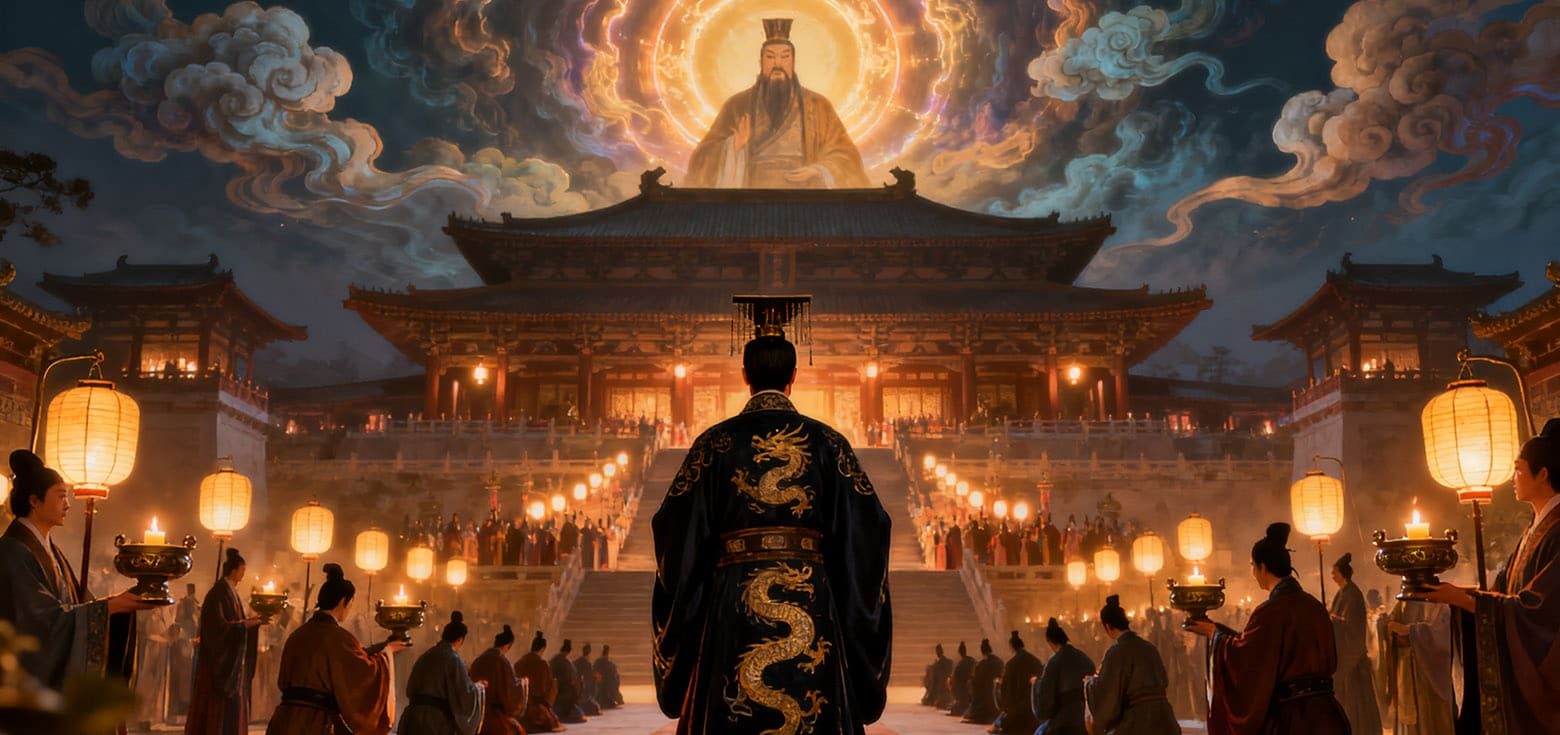
Traditional Chinese Lantern Festival Customs and Cultural Significance
The Lantern Festival is celebrated with a variety of vibrant activities, primarily including the following:
1. Admiring Lanterns
Admiring lanterns is the most important folk custom of the festival. The tradition of lighting lanterns began during the Eastern Han Dynasty and continued through the ages, making it a major folk holiday. The Tang Dynasty extended the lantern display from one night to three nights and saw the emergence of lively lantern markets.
By the Song Dynasty, the display period was extended to five or six nights. The lantern markets were unprecedentedly grand, with a dazzling array of colorful lanterns. During the Tang and Song dynasties, lantern markets also introduced lantern riddles and acrobatics, and by the Ming and Qing dynasties, theatrical performances were added.
Types of Lanterns: They vary widely in form, from simple hand-held lanterns to grand lantern displays. Common types include palace lanterns, gauze lanterns, fish lanterns, dragon lanterns, and spinning lanterns (zǒu mǎ dēng), which use hot air to create continuous moving images, often considered ancient animation.
Modern Light Festivals: Today, major light festivals like the Zigong International Dinosaur Lantern Fair combine traditional craftsmanship with modern sound, light, and electronic technology to create large-scale, themed lantern groups that have become city landmarks and major tourist events.
2. Guessing Lantern Riddles
Guessing lantern riddles is a traditional activity full of wit and fun. People write riddles on strips of paper and attach them to colorful lanterns for others to solve, which both inspires intelligence and enhances the festive atmosphere.
Format: Riddles often play on the meaning of characters through ideograms, pictographs, or homophones. The answers are typically a single character, a line of poetry, an idiom, or a place name.
Cultural Significance: This activity greatly increases the intellectual and participatory nature of the festival. It is a classic example of “learning through entertainment” from ancient times, showcasing the clever blend of literati culture and folk culture.
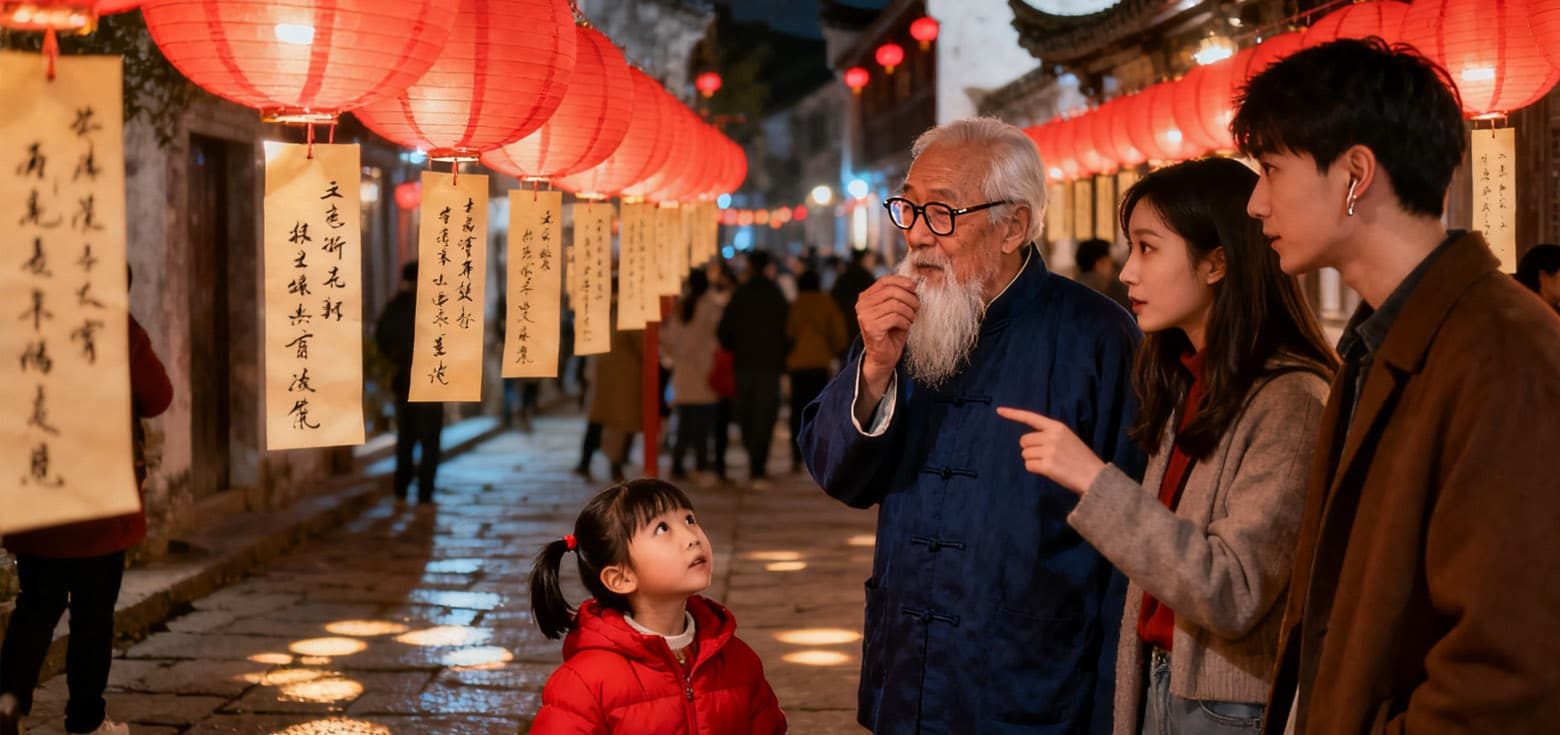
3. Eating Yuánxiāo or Tāngyuán
Eating yuánxiāo or tāngyuán is a significant dietary custom of the Lantern Festival.Yuánxiāo is called tāngyuán or shuǐyuán in the south. During the Tang and Five Dynasties, they were known as miànjiǎn or yuán bù luò jiǎo, and in the Song Dynasty, they were called yuánzi or tuánzi.
Ingredients and Fillings: The outer skin is made from glutinous rice flour, and the fillings can be sweet or savory. Sweet fillings include black sesame, peanuts, and red bean paste, while savory ones include minced meat and mixed vegetables, reflecting the culinary differences between northern and southern China.
Symbolism: The round shape of the dumplings symbolizes family reunion and a life of abundance. Sharing a hot bowl of yuánxiāo on this night of reunion serves as a direct emotional bond.
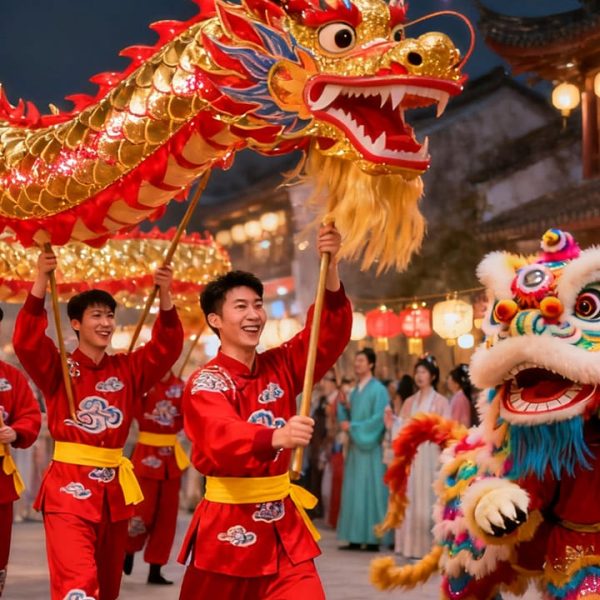
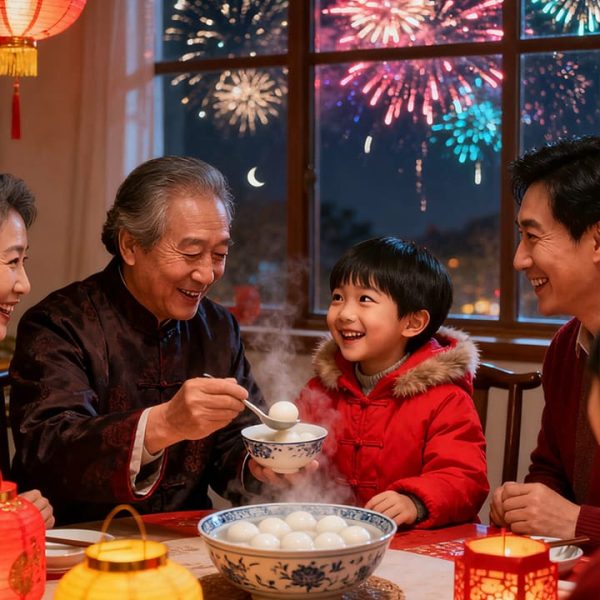
4. Dragon and Lion Dances
In many places, the Lantern Festival includes traditional folk performances such as dragon dances, lion dances, stilt-walking, land boat rowing, yāngge dances, and tài píng gǔ drumming. These performances are incredibly lively and add to the festive mood.
5. Setting off fireworks
In ancient times, setting off fireworks went hand-in-hand with the custom of lighting lanterns. This tradition originated from the Taoist and folk belief of using fire to ward off evil spirits and bring in good fortune, and it gradually gained popularity starting from the Tang Dynasty.
However, due to modern environmental and safety policies, most regions have either restricted the practice or shifted to centralized fireworks displays. Nowadays, eco-friendly alternatives like electronic fireworks and light shows are increasingly becoming a substitute for traditional fireworks.
6. Other Customs
Zǒu Bǎi Bìng / Chasing Rats: During the Ming and Qing dynasties, women would walk together at night, praying to get rid of all ailments, a custom known as zǒu bǎi bìng (“walking away from all illnesses”). In some regions, people would “chase rats” to protect silkworms from rodent damage.
Welcoming the Purple Maiden (Yíng Zǐ Gū): This involves worshipping the toilet goddess, the Purple Maiden, to divine the prospects of silkworm cultivation and predict fortune, reflecting the concerns of ancient agrarian society.
Romantic Encounters: In ancient times, the Lantern Festival was a rare occasion when the night curfew was lifted, allowing women to go out and enjoy the festivities. This led to many romantic stories, earning the festival the title of ancient Chinese “Valentine’s Day”
Ways to Celebrate the China Lantern Festival in Different Regions
Lantern Festival celebrations across different regions of China have their own unique characteristics:
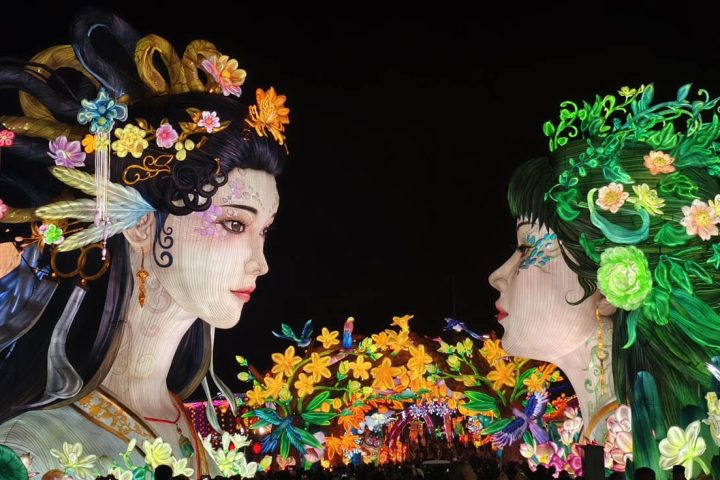
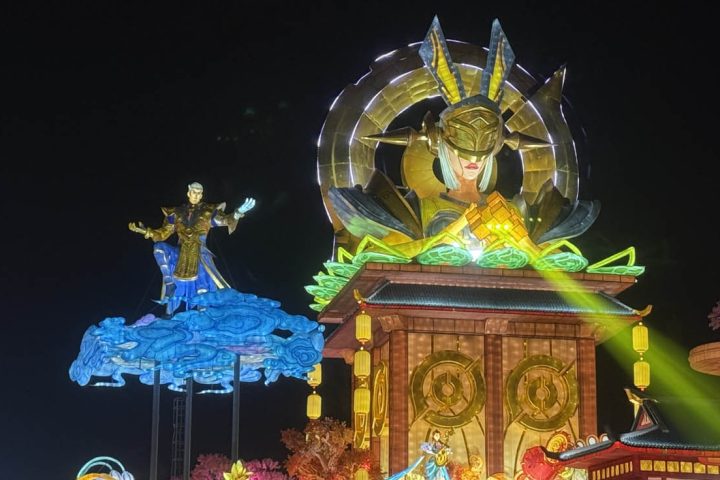
Chaoshan Region: There is a custom called zuò dīng zhuō (“making a son’s table”), where families who had a son in the past year host a banquet in the ancestral hall to celebrate. Another activity is “throwing the Maitreya Buddha,” where people throw coins at a giant Maitreya Buddha statue to hit the Chaozhou clay dolls on it and win one.
Hakka Region: The customs of “hanging lanterns” (shàng huā dēng) and “welcoming lanterns” (yíng dēng) are popular. A family that had a baby boy in the previous year must make a lantern, write the boy’s name on it, and hang it in the ancestral hall, which is called “adding a new lantern/son” (tiān xīn dēng/dīng).
Ninghua Region: The festival celebrations are colorful, including dragon dances, golden lion dances, puppet shows, and “Iron Stick Stories” (tiě gǎn gù shì). Featured lanterns include the “Civil and Military Lanterns” of Chijia Village, the “Tall Shelf Lanterns” of Huaitu, and the “Eggplant Lanterns” of Caofang.
Zigong: Known as the “China Light City,” Zigong lanterns are famous worldwide for their grand scale, clever design, and exquisite craftsmanship, developing the art of lantern-making into a vast cultural industry.
Beijing: In ancient times, Beijing was the site of imperial lantern fairs. The modern-day “Night of Shangyuan” event in the Forbidden City (Palace Museum) recreates the splendor of ancient court lantern fairs.
Shanghai:The Shanghai Yu Garden Lantern Festival is a perfect fusion of classical Jiangnan gardens and traditional lantern art. It’s renowned for its intricate designs and narrative-driven layouts.
The iconic Nine-Bend Bridge transforms into a stunning light formation, complemented by markets featuring time-honored brands and hands-on cultural heritage experiences. This combination beautifully showcases Shanghai’s local folk traditions and its modern aesthetic.
Nanjing: The Confucius Temple Lantern Fair has a long history. The Qinhuai River is filled with lantern boats, and the sight of oars and lanterns creates a distinctly Southern Chinese ambiance.
Taiwan: In addition to admiring lanterns, a unique tradition is “releasing sky lanterns” (fàng tiān dēng or Kongming lanterns). People write their wishes on the lanterns and send them to the sky to be fulfilled (this is most famous in Pingxi).
Southern vs. Northern China: The debate over the names “tāngyuán” and “yuánxiāo” and the preference for sweet or savory fillings are interesting examples of cultural differences.
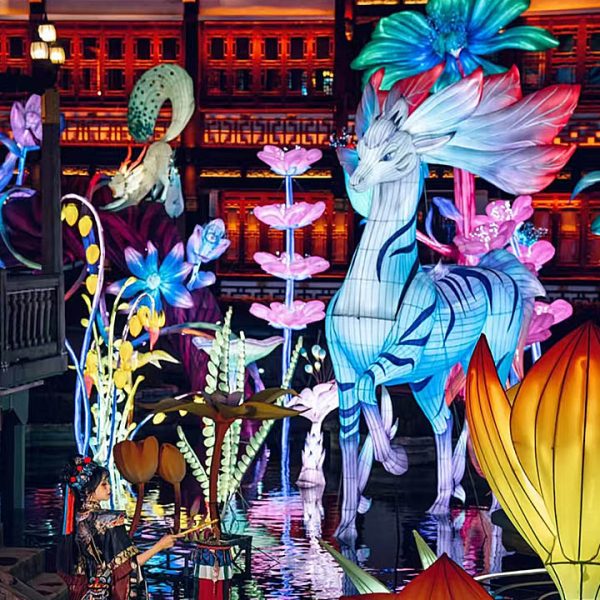
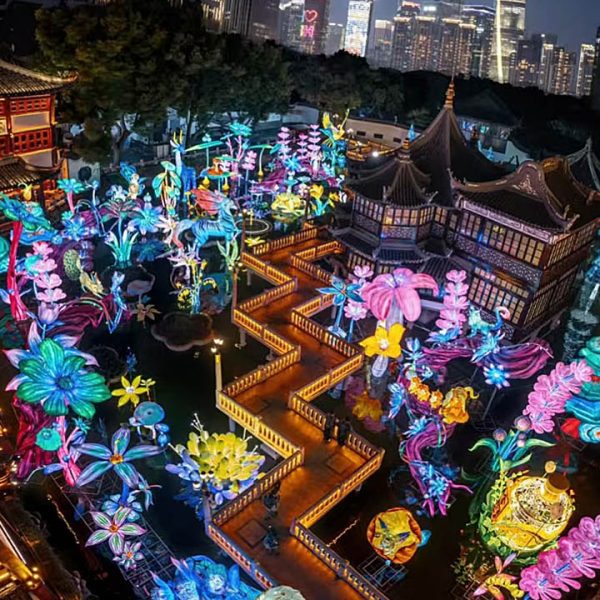
The Symbolism of Lantern Festival Foods
The Chinese Lantern Festival foods are incredibly diverse, and each dish carries its own symbolism:
Yuánxiāo / Tāngyuán: Symbolize reunion and happiness. Southern tāngyuán has a soft texture, while northern yuánxiāo is chewier.
Nián gāo (Rice Cake): Also known as “sticky cake” (nián gāo), it has different northern and southern flavors and symbolizes “rising higher year after year”.
Dumplings (Jiǎo zi): In some northern regions, eating dumplings on the Lantern Festival symbolizes auspiciousness and reunion.
Yuánxiāo Tea: In some areas of Shaanxi, there is a custom of eating yuánxiāo tea, which is a wish for good health.
Noodles: In the Jiangbei region, a folk saying goes, “Eat yuánxiāo at the start of the lantern fair, and noodles at the end of it, and hope for a good year”. Eating noodles on the Lantern Festival symbolizes a long and continuous celebration.
The Artistic Evolution and Globalization of Chinese Lanterns
As a highly distinctive example of Chinese Lantern Festival lanterns, Zigong lanterns enjoy a very high reputation worldwide.Zigong lanterns are hailed as the “Number One Lanterns in the World,” with origins in the Tang and Song dynasties and a golden age in the Ming and Qing dynasties. Since their first international exhibition in Singapore in 1990,Zigong lantern festivals have been showcased in over 80 countries and regions worldwide. They hold an 85% market share of Chinese lantern exhibitions and a 92% share of overseas exhibitions.
The art of lantern-making is constantly innovating in its forms of expression, themes, materials, craftsmanship, and technology:
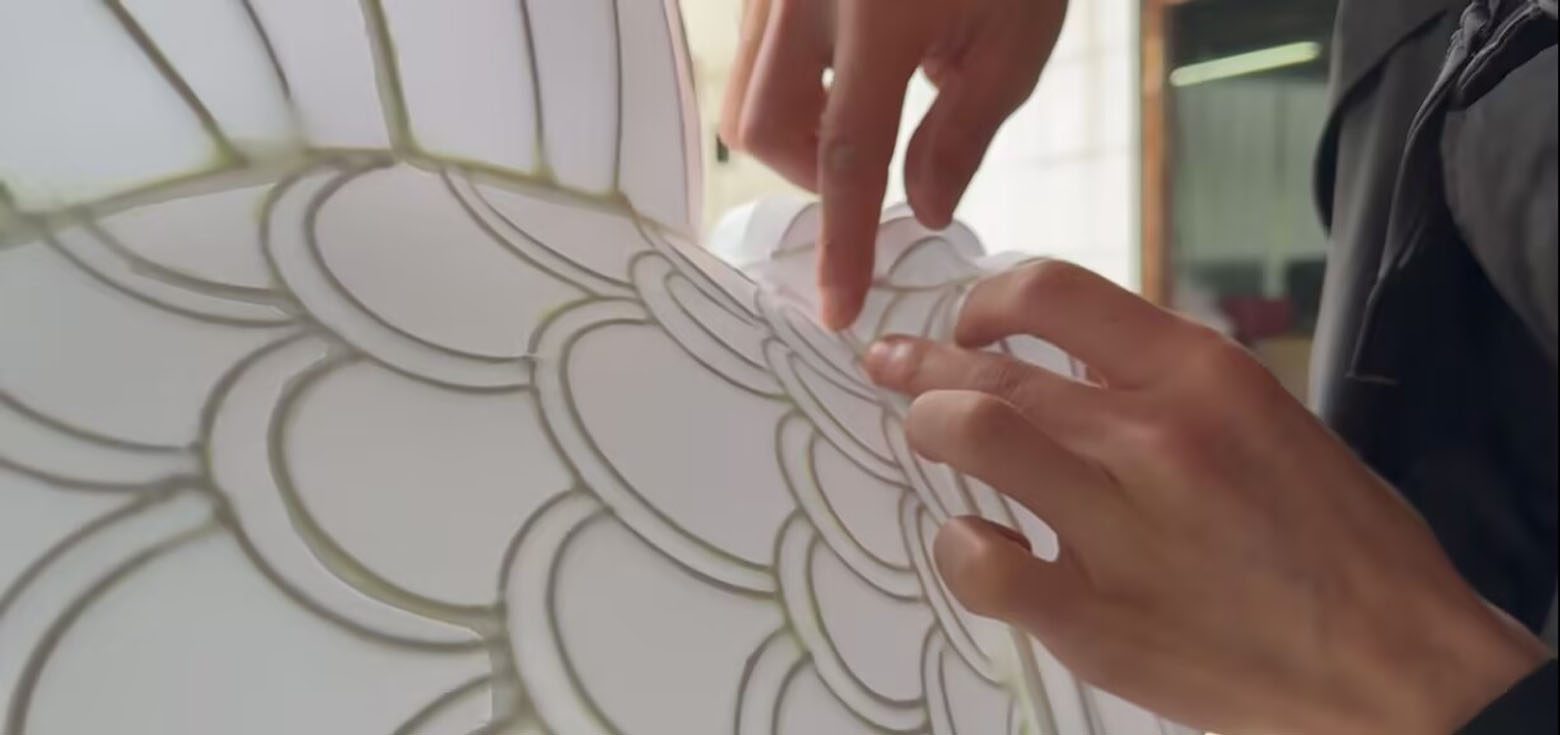
Diversified Themes: Themes have expanded from traditional ones like praying for blessings, myths, historical stories, fairy tales, and traditional operas to topics that are more relevant to modern life.
Technological Innovation: The integration of digital technologies like naked-eye 3D visual effects and AR virtual reality enhancement.
Material Innovation: Moving from traditional paper and silk to new materials like porcelain and glass.
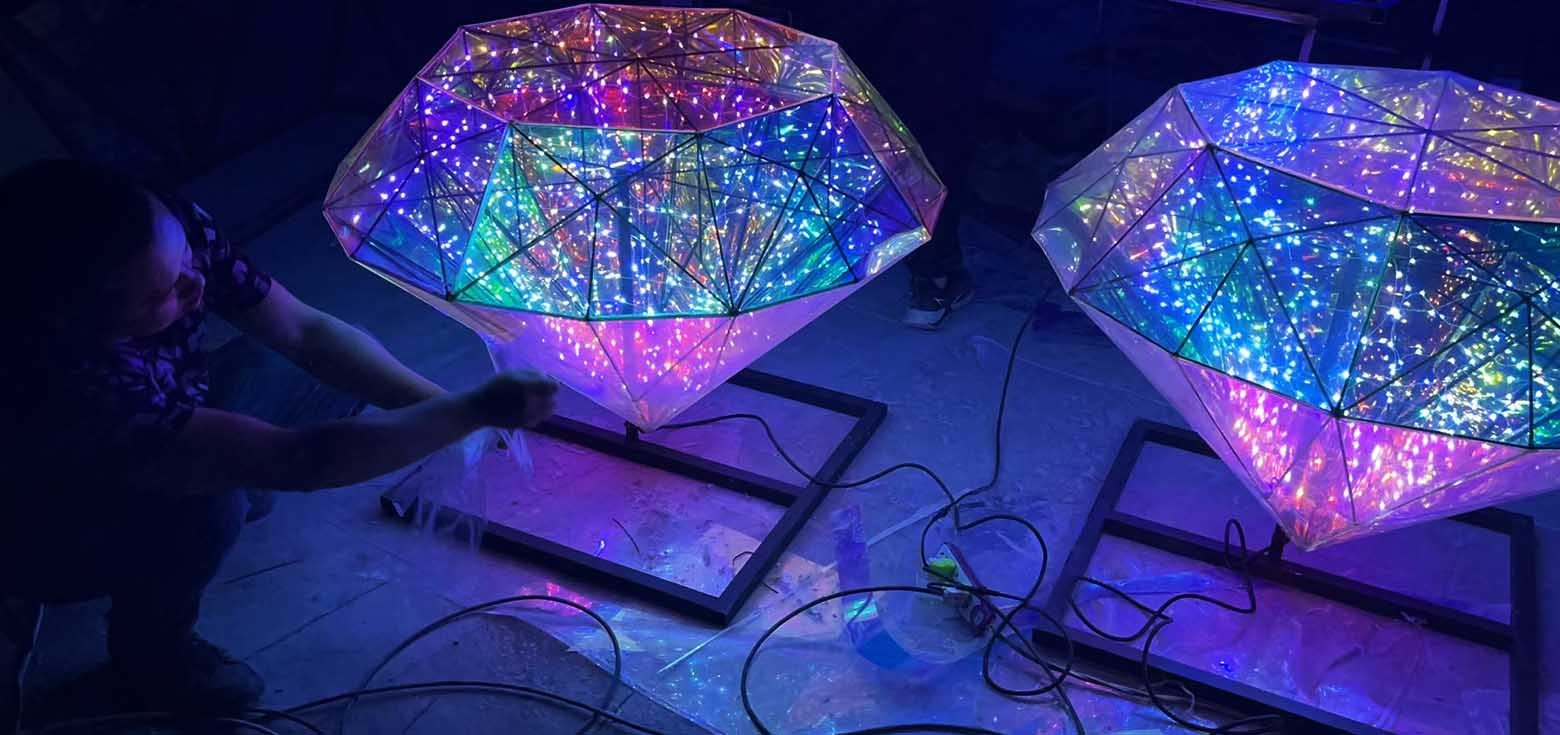
Table: Milestones in the International Development of Zigong Lanterns
Time | Event | Significance |
1990 | Zigong Lantern Festival travels to Singapore | Marked the beginning of overseas exhibitions. |
2000 | Created the “Chinese Millennium Lantern King” | 21 meters in diameter, symbolizing the 21st century; 16.6 meters high, symbolizing “smooth sailing all the way” (yī lù shùn fēng); 56 dragons, each 15 meters long, representing China’s 56 ethnic groups. |
2020 | Created the “Anti-Pandemic Themed Lanterns” | Presented China’s national anti-pandemic efforts in 15 lantern groups. |
2021 | Lit up lanterns in multiple countries including the U.S., Singapore, France, and the U.K. | Despite the global pandemic, the company persevered and continued to spread Chinese culture. |
2022 | Lantern Fair in Blagnac, France | Exhibited 40 groups of Zigong lanterns showcasing representative Chinese and French architecture, culture, folklore, and technology. |
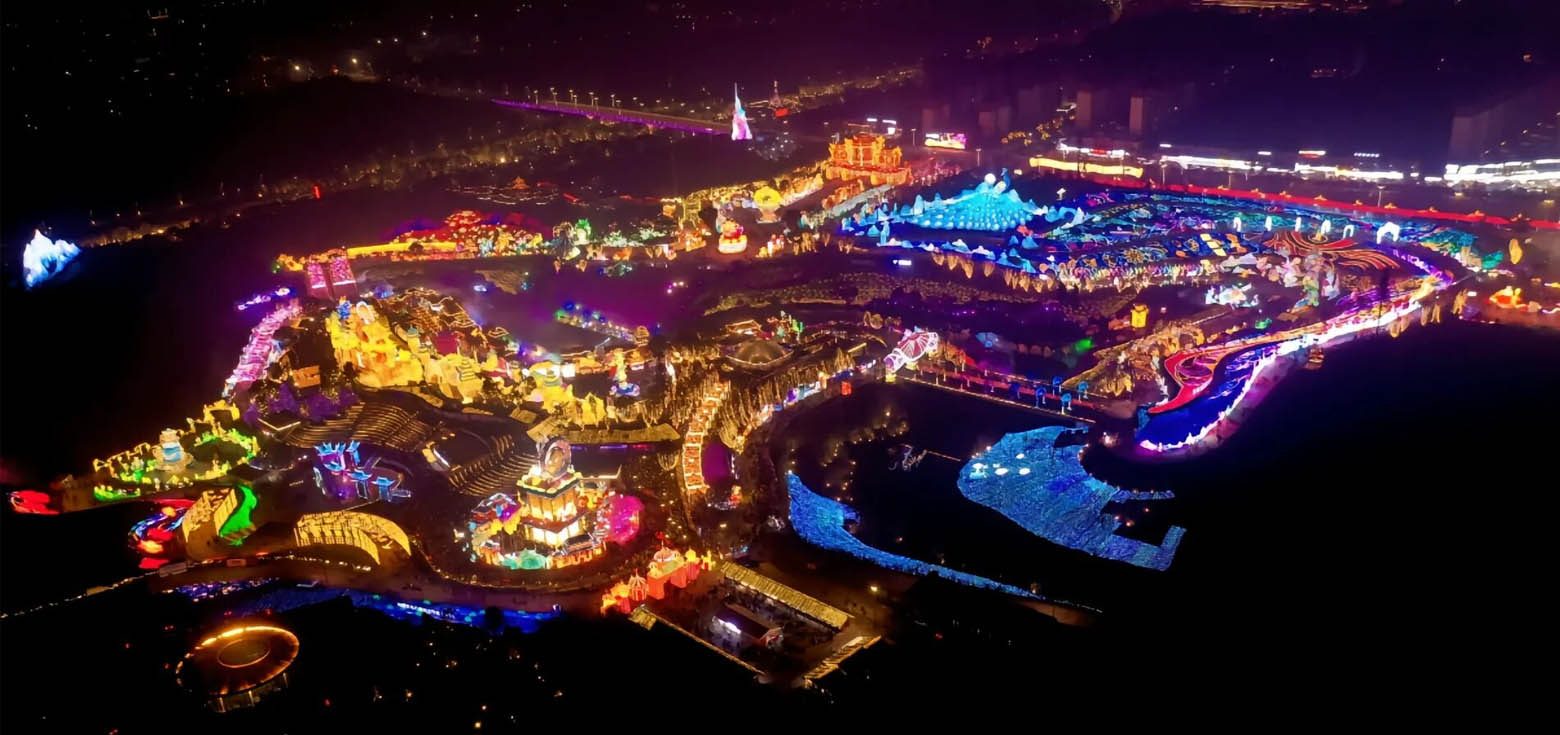
Tip: Want to learn more about how Chinese lanterns are achieving global success? Read our article, “The Globalization of Chinese Lanterns: An Interpretation” for a more in-depth understanding.
Overseas Dissemination and Influence of the Lantern Festival
The Lantern Festival is more than just a traditional Chinese holiday—it has a widespread influence around the world. On the same day, some Asian countries host their own versions of the Asian Lantern Festival that blend with local customs, while Chinese communities across the globe also come together to celebrate this festival of lanterns:
Japan: Japan has two New Year periods, “koshōgatsu” (Little New Year) and “ōshōgatsu” (Great New Year). January 15th is called koshōgatsu, and there is a custom of eating red bean porridge in the morning. On the fifteenth day of the first lunar month, Japan’s Chinatowns hold lantern-admiring events for the festival.
South Korea: The fifteenth day of the first lunar month is called “Jeongwol Daeboreum”, which means “the great full moon of the first month”. On this day, Koreans eat five-grain rice and various nuts. They also drink “clear ear wine” to pray against ear diseases in the new year.
Vietnam: The Lantern Festival signifies that the Lunar New Year is over, and everyone should fully dedicate themselves to work. Families gather at noon for a “New Year opening meal,” and bánh chưng (a type of rice cake) is an essential part of the meal.
Singapore: With a large Chinese population, Singapore has retained traditional Chinese customs like eating yuánxiāo and admiring lanterns. Chinatown is decorated with various lanterns, and people visit temples to pray for blessings in the new year.
Malaysia: Single Chinese men and women have a custom of “throwing oranges and receiving bananas”. Men throw bananas, and women throw oranges, with their contact numbers written on the fruit, hoping to find a good marriage partner.
Cultural Roots of Overseas Chinese: In Chinatowns around the world, the Lantern Festival is one of the most important annual cultural events. It serves not only as an emotional anchor for Chinese people but also as a window to showcase Chinese culture to mainstream society, promoting cultural diversity.
Lantern Festivals Around the World: With the rise of China’s cultural influence, the Lantern Festival is gradually becoming known and experienced by more people worldwide, much like Christmas or Valentine’s Day. Many major international cities now host Chinese Light Festivals, attracting visitors from all over the world and making it a cross-cultural “carnival of light”.
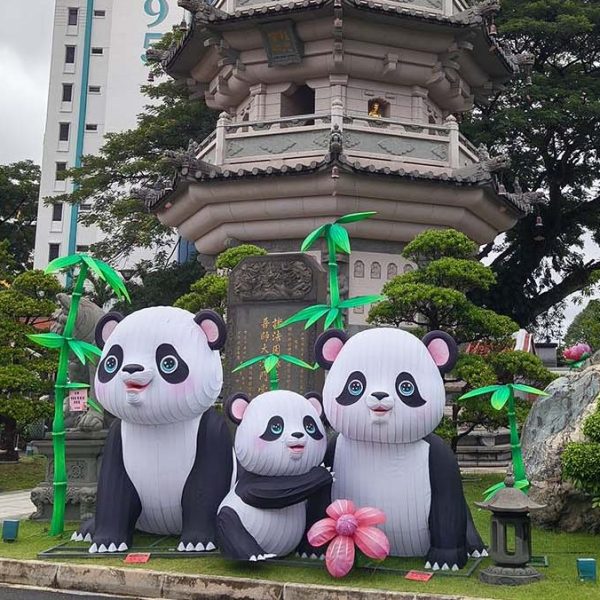
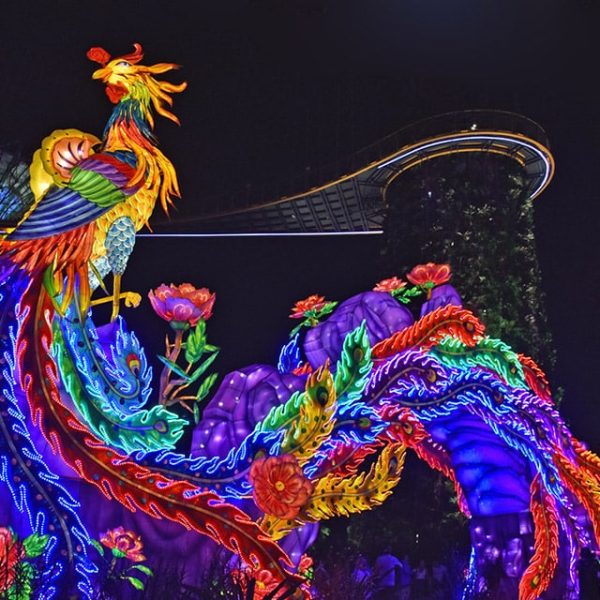
Passing Down Traditional Festivals in the Modern Age
Traditional festivals are the most effective vehicle for cultural heritage. They are of great significance for enhancing the Chinese people’s national confidence and their sense of mission to revitalize the Chinese nation.
In this era of globalization and the impact of diverse cultures, we should pay special attention to exploring and preserving the culture of traditional festivals. Traditional festivals are becoming world cultural heritage, and preserving them means preserving cultural heritage and maintaining the diversity of the world’s cultural ecosystem.
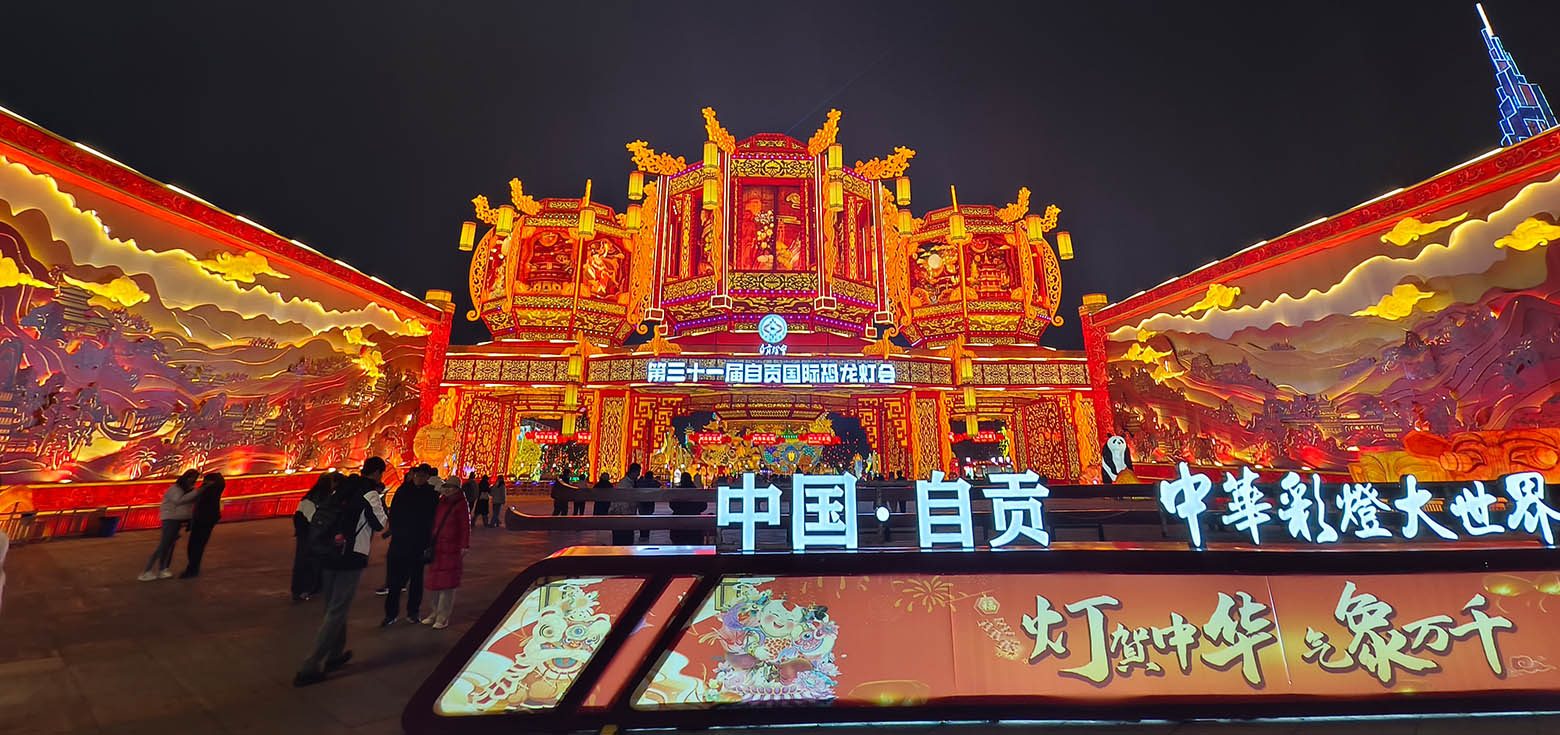
Today, celebrating the Lantern Festival has new contemporary significance:
A Symbol of Cultural Confidence: In a globalized context, traditional festivals are an important way to awaken national collective memory and build cultural confidence.
A Bond for Emotional Connection: In the fast-paced modern life, it provides a strong reason for families to reunite and friends to gather, helping to alleviate modern emotional alienation.
An Engine for Cultural Tourism: Large-scale lantern fairs have become a significant cultural tourism IP that drives winter tourism and stimulates consumption.
A Laboratory for Art and Technology Fusion: Modern lantern art continuously incorporates new materials and technologies (such as LEDs, mechanical transmission, AR/VR), bringing unprecedented vitality to this ancient intangible cultural heritage.
The contemporary innovation of the traditional Chinese Lantern Festival is reflected in several aspects:
Technological Integration: Using digital technologies like VR and AR to enhance the viewing experience.
Environmental Concepts: Using eco-friendly and biodegradable materials for lanterns.
International Expression: Integrating local cultural elements, such as the “Peter Rabbit” lanterns at Longleat Estate in the UK.
Social Relevance: Reflecting contemporary themes, such as the anti-pandemic lantern groups.
And ForestPaintingLantern was born at the peak of this wave of convergence between ancient tradition and modern innovation.
Rooted in Zigong, the “China Light City,” we are not just lantern manufacturers; we are also preservers, interpreters, and global disseminators of Chinese Lantern Festival culture. We are committed to:
Passing Down Craftsmanship: Upholding the millennia-old lantern-making techniques, we strive to make every lantern a collectible work of art.
Empowering Innovation: We use cutting-edge technology to inject soul into traditional lanterns, creating breathtaking, immersive experiences.
Extraordinary Planning: We will do more than just provide products; we offer complete light festival planning solutions—from theme conception, lantern design, production, and installation to event operation—to authentically reproduce the most genuine Chinese Lantern Festival celebrations, either in their original form or adapted to local conditions, anywhere in the world.
One lantern illuminates a reunion; one lantern fair brightens a city. Let’s join hands and let this light and warmth, which have traveled through thousands of years, shine on every corner of the world that longs for celebration and hope.
Conclusion:Let the Light of the Lantern Festival Illuminate the World
The Lantern Festival holds an irreplaceable emotional significance for the Chinese people, and its various celebratory activities like eating yuánxiāo and guessing lantern riddles have become a part of their cultural memory. Traditional festivals like the Lantern Festival are both a concentrated reflection of excellent traditional culture and a vehicle for its transmission.
With the development of technology and the integration of cultural creativity, this ancient festival is bound to continue shining brightly in the new era, making new contributions to the diversity of world civilization.
As a preserver and innovator of Chinese lantern culture, ForestPaintingLantern will continue to delve into the cultural significance of the Lantern Festival. Through the art of lanterns, we will tell China’s stories well and promote the creative transformation and innovative development of excellent traditional Chinese culture.
Let us look forward to a future where, in the context of globalization, more places around the world can light up Eastern lanterns, collectively share the unique charm of Chinese culture, and add a brilliant Chinese color to the diversity of the world’s cultural ecosystem.
Chinese Lantern Festival FAQ
Have more questions? Feel free to contact us.
When is the chinese lantern festival?
The Chinese Lantern Festival is traditionally celebrated on the 15th day of the first lunar month. In 2026, it will be on March 3rd.
Why is the Lantern Festival Celebrated?
The Lantern Festival is celebrated for several key reasons, including family reunion, passing down traditions, and welcoming the new year. It combines cultural commemoration with folk beliefs to express hope for the future.
Where is the Lantern Festival celebrated?
In some Chinese cities, grand celebrations are held every year for the Lantern Festival, mostly centered around large-scale Chinese light festivals. Examples include the Zigong International Dinosaur Lantern Festival, Shanghai Yuyuan Lantern Festival, and Nanjing Qinhuai Lantern Festival.
Celebrations for the Lantern Festival abroad are also often organized by local Chinese communities or governments. If you’re interested, you can inquire about them locally in advance.
Why is the YuanXiao Festival called "Chinese Valentine's Day"?
The YuanXiao Festival is sometimes called “Chinese Valentine’s Day” because in ancient times, it provided a rare opportunity for unmarried men and women to meet. Strict restrictions on women’s movement in feudal society meant they were often confined to their homes. However, the custom of admiring lanterns and solving riddles on this day allowed them to go outside and meet young men among the festive lights. Many beautiful love stories began this way.
The romance of the YuanXiao Festival is more about “chance encounters,” while the Qixi Festival (the true Chinese Valentine’s Day) originates from the myth of the Cowherd and the Weaver Girl, with its themes of undying love and the pain and longing of separation.
What's the difference between Yuanxiao and Tangyuan?
Eating Tangyuan or Yuanxiao on the Lantern Festival symbolizes reunion, happiness, and harmony. Although they have similar names(They are both referred to as sweet rice balls.), their preparation methods and regional popularity are quite different:
Yuanxiao: Primarily popular in Northern China, Yuanxiao are made by “rolling.” The fillings are cut into small pieces and then placed in a basket filled with glutinous rice flour. The basket is rolled back and forth until the fillings are evenly coated. The cooked Yuanxiao have a firmer, chewier texture.
Tangyuan: Mainly popular in Southern China, Tangyuan are made by “wrapping.” Glutinous rice flour is mixed with water to form a dough, and the filling is then wrapped inside, much like a dumpling. The cooked Tangyuan have a softer, stickier texture, and the fillings are more varied.
What are some lesser-known Lantern Festival customs?
Besides the popular customs of admiring lanterns and eating Tangyuan, the Lantern Festival has a variety of rich traditions in different regions:
Solving Lantern Riddles: Originating in the Southern Song Dynasty, this custom involves people writing riddles on paper and attaching them to lanterns for others to guess. It was considered a sophisticated and elegant pastime for scholars.
Walking for Health (“Zou Baibing”): A custom in some northern regions where women would walk together, often crossing bridges or walking along city walls, to symbolize ridding themselves of illness and ensuring long life.
Stilt Walking: A type of folk performance where performers on stilts engage in various acrobatic and dance routines.
Dragon and Lion Dances: In some places, dragon and lion dances are important parts of the Lantern Festival celebrations, symbolizing the warding off of evil spirits and the bringing of good fortune.
How has the Lantern Festival's lantern culture evolved?
The history of Lantern Festival lanterns is long and rich. Originally, lanterns were practical tools for lighting, but they gradually evolved into festive decorations and works of art. From the elaborate displays in ancient imperial courts to the simple bamboo-frame lanterns of the common folk, the techniques and materials used to make them have continuously developed.
Modern lantern innovation is mainly reflected in the fusion with modern technology:
Technological Integration: Contemporary lanterns are no longer limited to traditional materials. They widely incorporate LED lights, projections, sound, and other technologies to create more visually stunning effects.
Diverse Themes: Beyond traditional animal and plant shapes, modern lanterns often feature themes like animated characters, historical events, and futuristic technology, attracting a younger audience.
How do modern young people celebrate the China Lantern Festival?
With social development and urbanization, the way the Lantern Festival is celebrated has also changed:
Celebration Venues: Traditional rural customs like folk performances and stilt walking are gradually decreasing. They are being replaced by large-scale urban events like lantern festivals, cultural fairs, and various themed activities.
Youth Participation: The younger generation is no longer just passively participating in traditional activities. They’re celebrating the festival in new ways, such as by sharing photos of their homemade Tangyuan on social media or playing online riddle games, infusing this ancient festival with new life.





